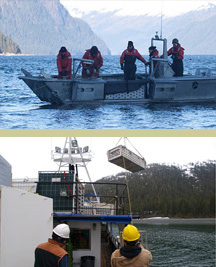Telemetry on Wild Sea Lions: Capture
 Capturing juvenile Steller sea lions for Life History Transmitter implantation is one of the most exciting aspects of the research since scientists work closely with the animals. Researchers venture out to sea on various vessels including the Norseman (above, right), a fishing vessel converted to support research. From the larger support ship, scientists travel a short distance to places where juveniles congregate near haul-outs using two small open boats.
Capturing juvenile Steller sea lions for Life History Transmitter implantation is one of the most exciting aspects of the research since scientists work closely with the animals. Researchers venture out to sea on various vessels including the Norseman (above, right), a fishing vessel converted to support research. From the larger support ship, scientists travel a short distance to places where juveniles congregate near haul-outs using two small open boats.
Out of water, juvenile Steller sea lions are shy, but in water juveniles are often surprisingly curious (view video>>). Researchers use the animals’ curious nature to their advantage. Trained divers enter the water from the small dive support boat with a special lasso. Underwater the curious sea lions swim up to the loop and some will even try to swim through it. The divers then carefully coax a single sea lion into the loop, and then send up a signal buoy. The lasso loop is also attached to a long rope with a large buoy at the other end. The buoy attached to the sea lion is carefully designed to break away under too much tension so that the animal will not harm itself or get stuck. It also has a quick-acting corrosible link in case an animal with a loop around its neck gets away.
 Now the team in the second small boat moves close to the lasso buoy and hauls it in. Once the animal is alongside the boat, they use a large tarp that they maneuver underneath the animal to lift and roll the sea lion into a specialized cage. It takes five team members pulling their hardest to get the roughly 120-200 kg sea lion into the cage. The team then takes the capture cage to the main vessel, which is standing by ready to receive the sea lion.
Now the team in the second small boat moves close to the lasso buoy and hauls it in. Once the animal is alongside the boat, they use a large tarp that they maneuver underneath the animal to lift and roll the sea lion into a specialized cage. It takes five team members pulling their hardest to get the roughly 120-200 kg sea lion into the cage. The team then takes the capture cage to the main vessel, which is standing by ready to receive the sea lion.
On board, the veterinarian checks the animal’s health status and it’s age. If the animal is healthy and old enough (only juveniles between the ages of 1 and 2 years will be implanted), it is transferred to a roomier cage for transport by boat back to a coastal animal holding and facility. See Facilities for more information about such a coastal animal holding facility.